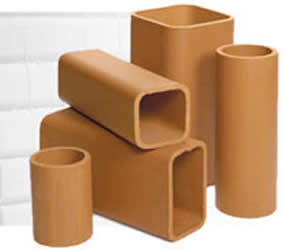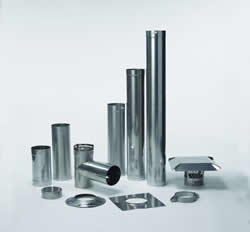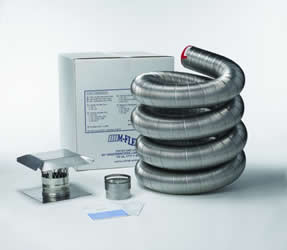
Figure 1 - Clay chimney tiles
Chimney liners are used to provide an air tight path for the venting of flue gases from a furnace, stove or other heating appliance to the outside of a building. Older chimneys are lined with clay tile, as shown in Figure 1; however clay tiles have a limited life span due to their operating environment. Clay tile chimney liners are exposed to a host of corrosive chemicals, weather and can be damaged or displaced by the normal settling of a home. While clay chimney tiles can be replaced, it is an expensive process.
The alternative to using clay chimney tiles is to use stainless steel chimney liners which are lowered from the top of the chimney to the bottom. Stainless steel chimney liners are manufactured in both rigid and flexible styles, each has advantages and disadvantages.

Figure 2 - Rigid stainless steel chimney liners
Features of Rigid Stainless Steel Chimney Liners (Figure 2):
- available in specific lengths; 12, 18, 24, 36 & 48 inch lengths,
- available in specific diameters; 5, 6, 7 & 8 inch diameters,
- smooth surface helps to prevent the buildup of creosote,
- rigid stainless steel chimney liner materials are less expensive than flexible stainless steel chimney liner materials,
- installation cost is generally more expensive for a rigid stainless steel chimney liner than a flexible stainless steel chimney liner.
- best used in situations where the chimney flue is completely vertical without any bends,
- available in 304L stainless steel for wood burning appliances and 316L stainless steel for all types of fuels,
- joints provide a potential area for leaks to occur in the future.

Figure 3 - Flexible stainless steel chimney liners
Features of Flexible Stainless Steel Chimney Liners (Figure 3):
- available in continuous lengths up to 50 feet
- available in specific diameters; 3, 4, 5, 5 1/2, 6, 7 & 8 inch diameters,
- the inside surface of a flexible stainless steel chimney liner has a corrugated texture (although there are some manufacturers now making flexible stainless steel chimney liners with a smooth interior finish). Some chimney experts believe that because the flexible chimney liner expands and contracts with changes in temperature that the movement of the corrugations may actually help to break up any creosote buildup that may occur,
- flexible stainless steel chimney liner materials are more expensive than rigid stainless steel chimney liner materials,
- installation cost is generally less expensive for a flexible stainless steel chimney liner than a rigid stainless steel chimney liner,
- easily installed in chimneys that are completely vertical and those that are vertical with bends,
- available in 316L stainless steel,
- no joints within the chimney liner itself, makes it a safer, long term installation,
Note: Both rigid and flexible stainless steel chimney liners can be purchased as kits or individual pieces.
Note: If you are installing a stainless steel chimney liner for either pellet or corn fuels you must purchase a liner that has been manufactured to UL 1777.
Additional Information:
How To Choose A Metal Chimney Liner.
